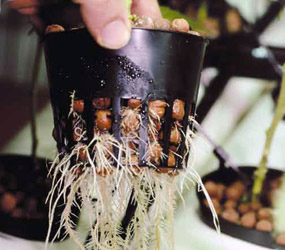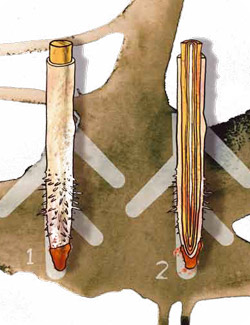Hawaii Cooperative Extension Service
Horticulture Digest #102
WHAT IS THE TRUE PLUMERIA FRAGRANCE?
In the proof-reading phases of the University of Hawaii’s Plumeria Cultivars in Hawaii bulletin 158, the editor disagreed with the authors on the nature of the fragrance of several of the plumeria cultivars. It brought to mind the differences that people come with in describing odors. Plumeria flower fragrances can be described as weak, mild or strong, with the strongly scented ones characterized in terms of other fragrances: citrus, coconut, rose, cinnamon, carnation, jasmine, gardenia, fruity, or even woody.
RESULTS
‘Common Yellow’
In ‘Common Yellow’ 73 different compounds were identified by comparing their mass spectra and GC (gas chromatography) retention times with those of reference chemicals, while 67 were identified in ‘Irma Bryan’. It is possible that differences such as thes e could be used sometime to help distinguish between other cultivars which are closer in appearance.
‘Common Yellow’ has as major components the compounds phenylacetaldehyde and linalol (16.1 and 14.1 percent, respectively). Also present are:
- trans, trans farnesol (11.0%),
- beta phenylethyl alcohol (8.8%),
- geraniol (5.4%), and
- alpha-terpineol (2.8%).
Two other compounds, neral and geranial, with lemon-like fragrances were present (comprising together 0.9%) which help account for the characteristic citrus scent of this flower.
‘Irma Bryan’
‘Irma Bryan’ had a very different makeup, although phenylacetaldehyde (12.1%) was still present. Beta-phenylethyl alcohol comprised 31.6% of the essential oil, about 3 times as much as in ‘Common Yellow.’ It has a mild, warm, rose-honey-like odor. The phe nylacetaldehyde has a powerful and penetrating, pungent-green, floral and sweet hyacinth-type odor.
Other volatiles that were present in the ‘Common Yellow’ flowers were either absent or present at much lower levels in ‘Irma Bryan,’ while methyl cinnamate (1.0%) and 2-methylbutan-1-o1 (10.5%) were found in the red ‘Irma Bryan’ flowers and not in the ‘Co mmon Yellow.’ Methyl cinnamate has a powerful fruity-spicy odor and seems to characterize ‘Irma Bryan’ while the 2-methylbutan-1-o1 does not seem to contribute to its scent.
Does it make the wonderful plumeria fragrance the less exquisite to know that 12 hydrocarbons, 21 alcohols, 13 esters, 8 aldehydes, and 20 miscellaneous compounds were detected?
So, when asked what creates the wonderful plumeria scent, you can reply authoritatively and quote the chemical names. On the other hand, you can paraphrase Joyce Kilmer and state that only God can make a plumeria.
EXPERIMENT
In the summer of 1991, Japanese researchers collected plumeria flowers in Hawaii to analyze them. The cultivars chosen were the ‘Common Yellow’ and ‘Irma Bryan’ forms of Plumeria rubra L.
Nearly a pound of flowers of each cultivar were subjected to steam distillation and extraction with organic solvents to derive a mere 70 milligrams (0.002 oz) of essential oil. Gas chromatography and mass spectrometry analyses were carried out to characte rize the various volatile components.
References:
Chinn, J. T. and R. A. Criley. 1983. Plumeria cultivars in Hawaii. HAES Research Bulletin 15 8. (Out of Print)
Omato, A., K. Yomogida, S. Nakamura, S. Hashimoto, T. Arai, and K. Furukawa. 1991. Volatile components of plumeria flowers. Part I . Plumeria rubra forma acutifolia (Poir.) Woodson cv. Common Yellow. Flavour and Fragrance Journal 6:277-279.
Omato, A., S. Nakamura, S. Hashimoto, and K. Furukawa. 1992. Volatile components of plumeria flowers. Part II. Plumeria rubra L. cv. Irma Bryan. Flavour and Fragrance Journal 7:33-35.
Richard A. Criley, criley@hawaii.edu
Department of Horticulture
University of Hawaii
 As mentioned, the root system will only increase in volume for as long as the rest of the plant continues to grow. However, transpiration from the leaves can also cause more roots to form in order to pump up the water needed. In the end, an equilibrium is established between the roots and the plant. A general rule of thumb is that the root system should comprise 30% of the total plant volume. Although this rule applies fairly consistently to plants in the open air, in substrate culture this does not always have to be the case. You can grow large plants in small pots as long as you supply them with water and nutrients and do not allow the pot to get too dry or too wet. To reduce the chance of this happening, we advise a large medium volume.
As mentioned, the root system will only increase in volume for as long as the rest of the plant continues to grow. However, transpiration from the leaves can also cause more roots to form in order to pump up the water needed. In the end, an equilibrium is established between the roots and the plant. A general rule of thumb is that the root system should comprise 30% of the total plant volume. Although this rule applies fairly consistently to plants in the open air, in substrate culture this does not always have to be the case. You can grow large plants in small pots as long as you supply them with water and nutrients and do not allow the pot to get too dry or too wet. To reduce the chance of this happening, we advise a large medium volume.